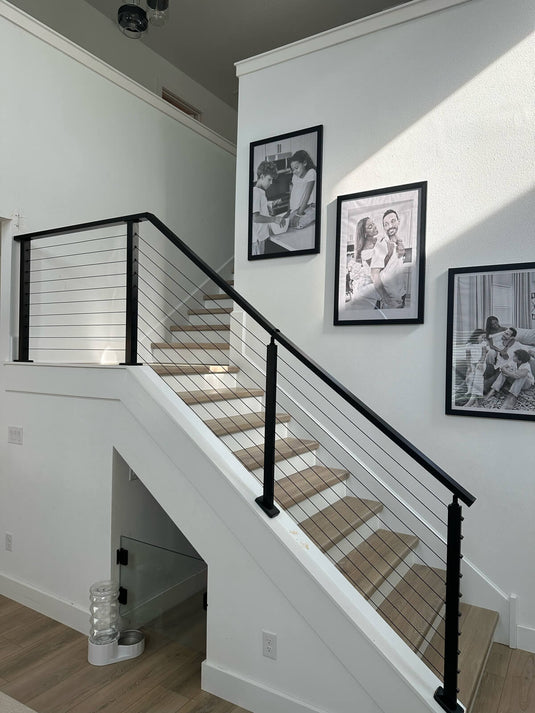TABLE OF CONTENTS
Top 10 Floating Stair Ideas for 2025
As we look towards the future of interior design, floating staircases continue to captivate both designers and homeowners alike, blending functionality with artistic expression. The popular trends for 2024/2025 bring a refreshing mix of innovative materials and architectural styles, transforming ordinary spaces into visually striking environments. From the integration of advanced lighting solutions to the strategic use of space-saving designs, these top 10 floating stair ideas showcase the evolution of home aesthetics, each tailored to enhance the modern living experience.
1. Central Spine Staircases
Central spine staircases are a prominent choice for modern interiors, leveraging a single, robust beam that runs centrally beneath the steps to create an illusion of floating treads. The design not only provides structural integrity but also introduces a sleek, minimalist aesthetic to any space. These staircases can be customized extensively—homeowners can choose from materials such as polished metal for a futuristic vibe or richly stained wood for a warmer, more traditional feel. The choice of material can significantly influence the staircase's impact on the home's overall decor, making it a versatile option for both contemporary and classic interiors.
In addition to aesthetic flexibility, central spine staircases are engineered for durability and can handle significant foot traffic, making them suitable for both residential and commercial properties. The open design helps to maintain a flow of light and space throughout the environment, enhancing the openness of the floor plan. Such staircases often become a focal point in a room, drawing attention not only to their functional purpose but also to their artistic form.

2. Cantilevered Concrete Stairs
Cantilevered concrete stairs offer a bold architectural statement with their clean lines and the illusion of treads floating off the wall. This design employs a hidden metal frame embedded within each concrete tread, which is then securely attached to the wall, eliminating the need for external supports. The result is a visually striking staircase that appears both sturdy and lightweight. Concrete as a material choice adds to the staircase's durability, making it an excellent option for both indoor and outdoor applications. It withstands various weather conditions, from intense sun to freezing temperatures, without compromising on aesthetics.
The functional benefits of cantilevered concrete stairs extend beyond their robustness. They are particularly advantageous in spaces where preserving the integrity of open areas is crucial. Without additional support structures, these staircases minimize visual clutter, thereby enhancing the visual continuity of the space. Furthermore, the use of concrete allows for a variety of finishes and colors, providing an opportunity to customize the look to fit any decor style, from industrial chic to modern minimalism. This type of staircase not only fulfills a practical purpose but also acts as a centerpiece, potentially increasing the property's value through its unique architectural contribution.
3. Glass and Wood Combination
The combination of glass treads with wooden handrails in staircases strikes a balance between modern elegance and classic warmth. Glass allows for the passage of light, contributing to an open and airy atmosphere that can make smaller spaces feel larger. It's particularly effective in enhancing natural light, as the transparency of glass can help distribute light throughout multiple levels of a home. This feature is complemented by the use of wood, which introduces a tactile warmth and can be tailored in style and finish to match various interior decors, from rustic to contemporary.
Moreover, the structural design of combining glass and wood involves careful consideration of safety and durability. Glass used for stair treads is typically tempered or laminated to ensure it can withstand regular use and bear significant weight without compromising safety. Wooden handrails provide a sturdy and comfortable grip, which is essential in any staircase design. This juxtaposition not only serves a practical purpose but also enhances the aesthetic appeal, offering a visually captivating element that can serve as the focal point of a home's architectural design.

4. Helical Staircases
Helical staircases, often compared to the spirals of a DNA molecule, offer a unique blend of artistry and function. They are designed to wind elegantly between floors without a central pole, providing a seamless transition that is both space-efficient and striking. This type of staircase is an excellent choice for those seeking to maximize floor space while also making a statement in terms of design. The curvature of helical stairs offers a continuous flow that can soften the angular lines of a room, providing a smooth aesthetic that complements various architectural styles.
The practical benefits of helical staircases extend to their versatility in different spaces and settings. They can be crafted from a range of materials, each adding a different character to the building—metal for a sleek, modern look, or wood for a more traditional feel. The design itself encourages a natural progression between levels, making it less steep and often more comfortable to ascend than traditional spiral staircases. Additionally, the open risers and absence of a central column enhance the visual connectivity between floors, making helical staircases a preferred choice in open-plan homes where maintaining visual flow is key.
5. Staircase Libraries
Staircase libraries effectively utilize the often-overlooked space beneath each stair tread, transforming it into functional book storage. This design not only maximizes the use of available space but also adds a significant aesthetic and intellectual charm to any home environment. It's particularly appealing for book lovers or those who appreciate a literary element in their decor. The shelves are custom-built into the risers of the stairs, making them a seamless part of the home's structure. This approach not only saves floor space but also turns the staircase into an interactive library, where books are easily accessible and visually prominent.
Additionally, staircase libraries can be designed to fit various home styles, from traditional to contemporary, by adjusting the materials and finishes used for the bookshelves. Whether crafted from rich, dark woods for a classic look or sleek, painted panels for a modern approach, these libraries enhance the functionality and style of the living space. They also invite a unique interaction with the architecture, encouraging residents and guests to engage with the staircase not just as a passageway, but as a place of discovery and relaxation.
6. Split Staircases
Split staircases are an architectural feature that creates a dramatic statement in any setting, ideal for larger spaces with adequate room to accommodate their expansive layout. This staircase type branches into two separate directions at a landing, often leading to different areas of a home, which not only adds an element of grandeur but also increases the functionality of the staircase by directing traffic flow efficiently within large or busy homes. The design can be tailored to fit the interior style of the house, whether through ornate balustrades for a more traditional look or minimalist rails for a modern feel.
The visual impact of a split staircase is significant; it often serves as the centerpiece of an entryway or main hall, offering both aesthetic appeal and practical benefits. The landing area provides a natural pause in the ascent, which can be utilized for decorative displays or seating areas, enhancing the usability and enjoyment of the space. Moreover, split staircases can be designed with various materials and lighting to complement the home’s overall theme, ensuring that they not only serve as functional elements but also as integral parts of the home’s design narrative.
7. LED-Lit Stairs
Integrating LED lights beneath stair treads is a modern feature that enhances both safety and aesthetics. This lighting technique improves visibility, reducing the risk of falls, especially in low-light conditions. It also offers a dynamic design element that can transform the ambiance of a space. LEDs can be programmed in various colors and intensities, allowing homeowners to customize the look according to occasions or personal preferences. For instance, soft white lights can create a warm, welcoming pathway, while vibrant colors can turn the stairs into a focal point during gatherings or festive seasons.
The practical benefits extend beyond aesthetics; LED lights are energy-efficient and have a long lifespan, making them a cost-effective and environmentally friendly option. They can be discreetly installed beneath each tread or along the sides of the staircase, providing a seamless look that enhances the architectural lines of the stairs without intrusive fixtures.
8. Reclaimed Wood Stairs
Using reclaimed wood for stair treads is not only an environmentally responsible choice but also adds a unique character and story to a home’s interior. Each piece of salvaged wood brings its own history, texture, and patina, contributing to a rustic yet sophisticated look. This design choice is particularly well-suited to homes with an industrial aesthetic, where the natural imperfections and ruggedness of the wood complement metal railings and structural elements.
Reclaimed wood is also a durable option for staircases, as the wood has already been aged and weathered, making it less likely to warp or split. It pairs beautifully with metal supports or railings, which provide structural strength and a modern contrast to the wood's natural warmth. This combination not only ensures durability but also enhances the visual appeal of the stairs, making them a statement piece in the home’s decor.

9. Black Matte Stairs
An all-black floating staircase delivers a striking visual statement that is as bold as it is elegant. The use of matte black finish across all components of the staircase—from treads to railings—not only enhances the modern aesthetic but also introduces a dramatic flair that can anchor the design of any room. This color scheme is incredibly versatile, easily integrating into various interior styles. In a modern minimalist setting, it adds a sleek, understated elegance, while in more classical environments, it can serve as a bold contrast to more ornate decorative elements.
The matte finish helps in reducing glare and concealing fingerprints and smudges, which is particularly beneficial in high-traffic areas. Furthermore, black can make other colors pop and serves as a perfect backdrop for highlighting art pieces or furniture near the staircase area. Its adaptability and the strong visual appeal make the black matte staircase a popular choice for designers looking to create a focal point without overwhelming the space's existing decor.
10. Outdoor Floating Stairs
Outdoor floating staircases are specifically engineered to blend durability with style, making them perfect for enhancing exterior spaces without sacrificing functionality. These staircases typically use materials like weather-resistant woods or advanced composites, which are designed to withstand the elements while maintaining their aesthetic appeal over time. The inclusion of elements such as glass or cable railings adds to the open and airy feel, promoting not just safety but also visual connectivity with the landscape.
These materials are chosen for their ability to resist moisture, decay, and insect damage, ensuring longevity even under harsh weather conditions. The design of outdoor floating stairs often focuses on maximizing space and preserving views, making them an ideal choice for properties with scenic surroundings. Whether leading up to a deck or descending into a garden, these staircases provide a seamless transition between indoor and outdoor spaces, enhancing the overall flow and enjoyment of the property.
The Bottom Line
Floating staircases not only serve as a means of movement between floors but also as central pieces of art within the home. The diverse designs highlighted for 2024/2025, ranging from the rustic charm of reclaimed wood to the sleek sophistication of black matte finishes, offer options for every taste and home style. As these trends set the stage for future innovations, they reflect a deeper appreciation for craftsmanship and design ingenuity, promising to elevate the functionality and beauty of homes around the world.




